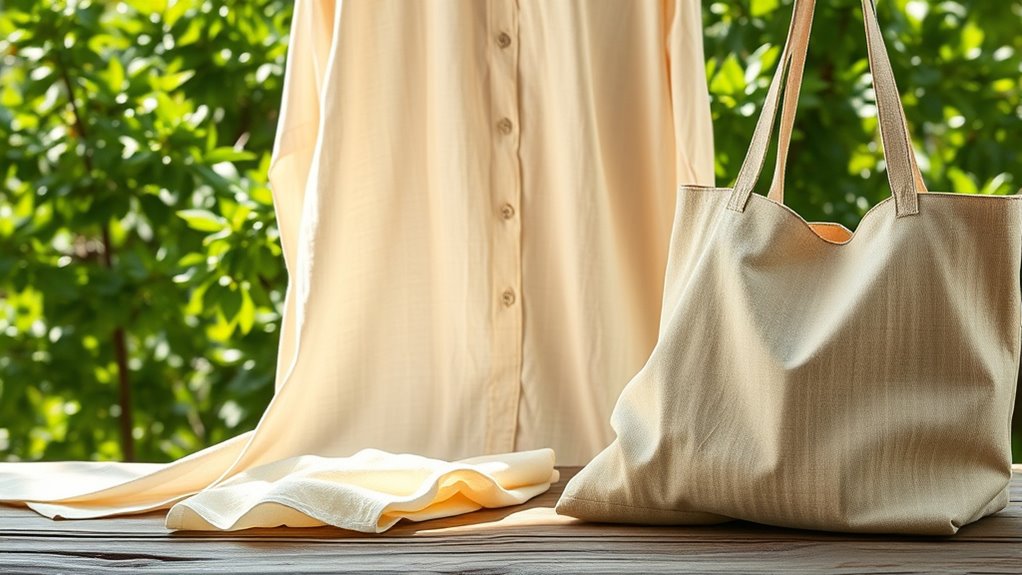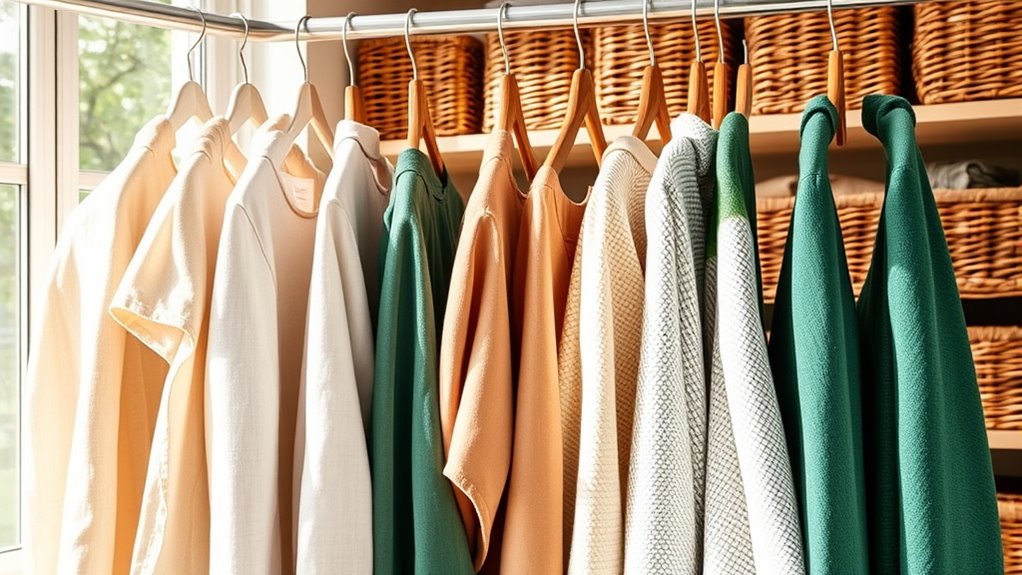Choosing sustainable fabrics like organic cotton, hemp, and linen helps you reduce environmental impact, support responsible farming, and promote recycling, while natural fibers are biodegradable and require less water and chemicals. However, blending fabrics and quality concerns can pose challenges. While these fabrics benefit the planet, some may have higher production costs or limited availability. To make truly eco-friendly choices that support a greener wardrobe, there’s more to discover on sustainable fabric options.
Key Takeaways
- Organic cotton and hemp are eco-friendly natural fibers grown without harmful chemicals, but they may require more land and water.
- Recycled fabrics reduce waste and resource use, though fiber quality can vary depending on the recycling process.
- Linen is biodegradable and durable, yet its production can be water-intensive and less sustainable if not farmed responsibly.
- Blended textiles pose recycling challenges and may compromise the environmental benefits of sustainable fabrics.
- Choosing certified sustainable fabrics supports responsible farming and recycling practices, enhancing environmental benefits in your wardrobe.

As more people seek to reduce their environmental impact, choosing sustainable fabrics becomes an essential step in building an eco-friendly wardrobe. One of the most effective ways to do this is by understanding how textiles are recycled and how natural fibers are cultivated. Recycling textiles involves transforming old, worn-out fabrics into new materials, which helps reduce waste and minimizes the demand for virgin resources. When you opt for clothing made from recycled textiles, you’re giving a second life to materials that might have otherwise ended up in landfills. This process conserves energy and water, making it a more sustainable choice overall.
Natural fiber cultivation is another critical aspect of sustainable fabrics. Unlike synthetic fibers derived from petrochemicals, natural fibers such as organic cotton, hemp, and linen are grown without harmful chemicals, pesticides, or excessive water use. By choosing fabrics produced from these cultivated fibers, you support farming practices that are less damaging to the environment. Additionally, natural fibers are biodegradable, meaning they decompose naturally without leaving lasting pollution behind. This reduces your clothing’s overall environmental footprint, especially when compared to synthetic alternatives that shed microplastics and persist in ecosystems for centuries.
However, it’s important to recognize some challenges associated with both recycling textiles and natural fiber cultivation. Recycling textiles can sometimes be limited by the quality of the original materials; not all textiles are easy to recycle, and blends of fibers can complicate the process. When textiles aren’t properly sorted or processed, the recycled fabric might not be as durable or high-quality. Similarly, natural fiber cultivation can have its drawbacks. For example, organic farming often requires more land and labor, which can make these fabrics more expensive. Additionally, while organic farming reduces chemical use, it still relies on sustainable practices, which might not be universally adopted by all producers.
Despite these challenges, incorporating recycled textiles and naturally cultivated fibers into your wardrobe is a significant step toward sustainability. It means supporting practices that conserve resources, reduce waste, and lower pollution. You’re helping push the fashion industry toward more responsible methods of production. When shopping, look for certifications and labels that verify natural fiber cultivation or recycled textile use. This way, you can confidently choose garments that are not only stylish but also environmentally conscious. Making these choices consistently will contribute to a greener planet and a more sustainable future for fashion.
Frequently Asked Questions
How Do Sustainable Fabrics Compare in Cost to Conventional Fabrics?
Sustainable fabrics generally cost more than conventional fabrics, mainly due to higher price factors like eco-friendly farming, ethical labor, and limited production. You might notice a higher cost comparison, but you’re investing in quality and environmental impact. While initial prices can be steep, long-term benefits like durability and reduced environmental footprint often justify the expense. So, weigh the cost factors carefully when choosing sustainable options for your wardrobe.
Are Sustainable Fabrics as Durable as Traditional Materials?
Think of sustainable fabrics as the steady oak in a forest—strong and resilient. They often match traditional materials in fabric longevity, so your clothes last longer and withstand wear. Plus, they reduce environmental impact by using eco-friendly processes and materials. While some sustainable fabrics might need gentle care, many are just as durable, making them a smart choice for both your wardrobe and the planet.
What Are the Best Sustainable Fabrics for Sensitive Skin?
If you have sensitive skin, opt for natural fibers like organic cotton, bamboo, or hemp, which are gentle and breathable. Look for fabrics dyed with chemical-free dyes to avoid irritation. These sustainable options reduce exposure to harsh chemicals, making them comfortable for your skin. Always choose high-quality, untreated fabrics to guarantee they’re as soft and safe as possible, helping you stay comfortable without sacrificing eco-consciousness.
Can Sustainable Fabrics Be Easily Recycled or Reused?
Sustainable fabrics can be recycled or reused, but recycling challenges often exist due to fiber blends and fabric treatments. You’ll find that many materials, like hemp or organic cotton, have good reuse potential because they’re durable and biodegradable. To maximize their sustainability, choose fabrics that are easy to recycle or repurpose, and support brands committed to transparency and eco-friendly recycling practices.
How Do I Identify Genuinely Eco-Friendly Fabrics in Stores?
To identify genuinely eco-friendly fabrics in stores, look for fiber certifications like GOTS or OEKO-TEX, which guarantee sustainable practices. Check the eco label significance, as it indicates environmental standards were met. You should also research the brand’s transparency about sourcing and manufacturing. By paying attention to these indicators, you guarantee your purchase supports truly eco-friendly fabrics that align with your sustainability goals.
Conclusion
Choosing sustainable fabrics is like planting seeds for a greener future—each fabric you wear nourishes the earth and your conscience. By weaving eco-friendly materials into your wardrobe, you become a gardener of change, cultivating a style that blooms with responsibility. Remember, every conscious choice is a brushstroke on the canvas of sustainability, turning your closet into a vibrant tapestry of mindful living. Embrace these fabrics, and watch your impact grow as beautifully as a garden in full bloom.








